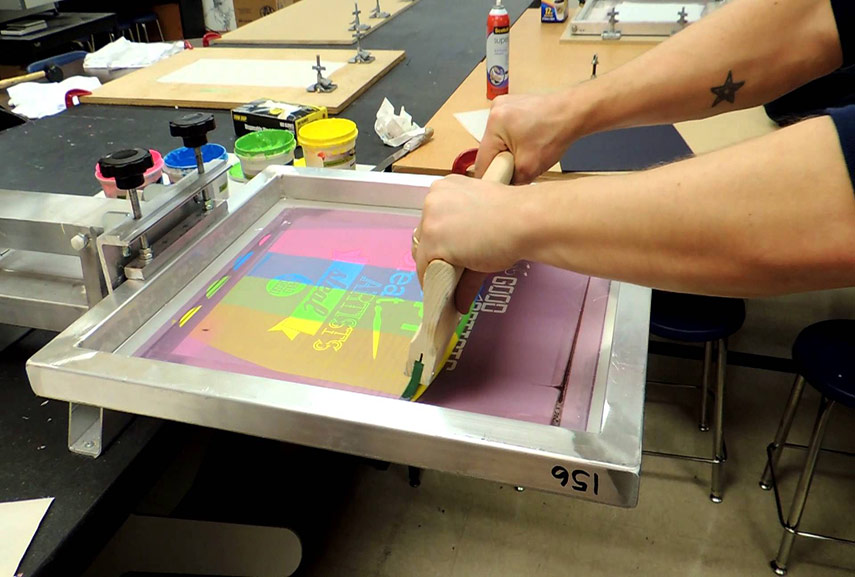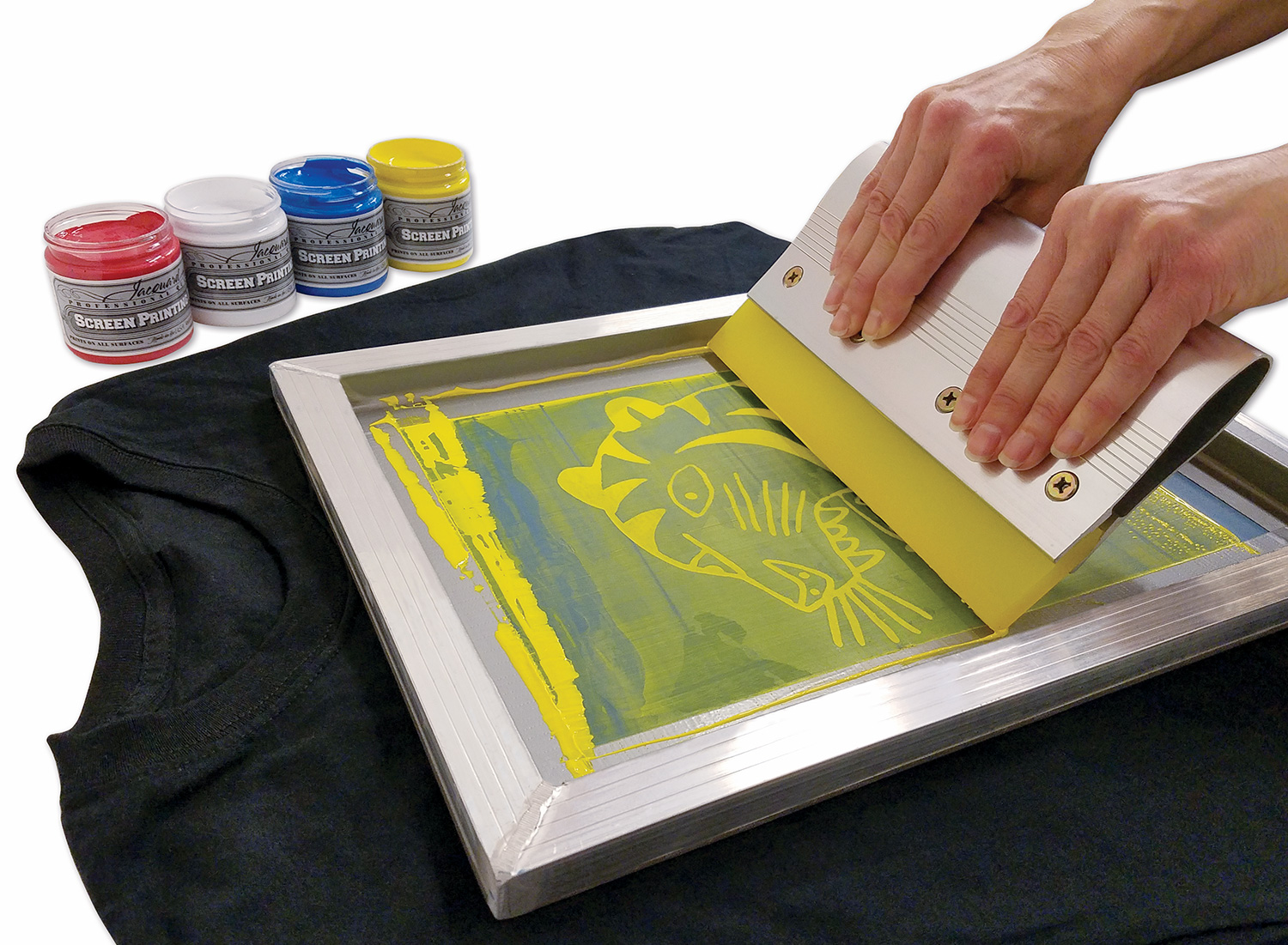Discover the Numerous Sorts Of Screen Printing Techniques for Your Following Task
Screen printing supplies a varied series of techniques that can enhance any kind of creative task. From typical approaches like serigraphy to modern-day technologies such as direct-to-garment printing, each approach has its unique benefits. Specialty choices, including green and metallic inks, introduce a lot more possibilities. Comprehending these strategies can substantially impact the final outcome. However, the challenge depends on choosing one of the most appropriate approach for particular demands and preferred results. What variables should one take into consideration?

The Essentials of Screen Printing
Although screen printing may seem complicated, it is fundamentally an uncomplicated procedure that involves transferring ink through a mesh screen onto various surfaces. The strategy starts with the development of a pattern, which specifies the design to be printed. This pattern is connected to a mesh screen, usually made from polyester or nylon. When the pattern remains in location, ink is used to the screen and pressed through the mesh making use of a squeegee, leading to the preferred pattern being published on the underlying material.
Screen printing can be carried out on a large range of substrates, consisting of paper, fabric, and plastic, making it a versatile option for different jobs. The procedure allows for dynamic colors and complex layouts, making it popular in sectors such as advertising, fashion, and art. Understanding these fundamentals equips people with the foundational expertise needed to discover more advanced techniques in screen printing.
Standard Screen Printing Techniques
Conventional screen printing methods have been employed for centuries, protecting the craftsmanship and creativity of this approach. This technique uses a mesh screen to move ink onto a substratum, such as textile or paper, allowing for long-lasting and dynamic designs. The process begins with developing a pattern, which obstructs specific locations of the screen to manage where the ink will certainly be applied.
One popular method is serigraphy, often used for imaginative prints and restricted versions. An additional is the use of water-based inks, which are eco-friendly and give a soft feel on fabrics - 10:9 Design LLC Company. Furthermore, traditional approaches can include hand-operated printing, where artisans use ink with a squeegee, guaranteeing accuracy and attention to information
These methods stay valued in the industry for their responsive top quality and the distinct appearances they create, attracting both makers and customers that value the heritage of screen printing.
Digital Screen Printing Innovations
As the need for faster production and modification in the printing sector has actually risen, digital screen printing technologies have emerged as a game-changer. This innovation mixes conventional screen printing methods with digital processes, enabling rapid prototyping and detailed styles that were formerly challenging to attain. One significant development is the introduction of direct-to-garment (DTG) printing, which promotes high-grade, full-color prints on various fabrics without the need for screens. Additionally, developments in ink formulas have led to environment-friendly choices that preserve lively shades while decreasing environmental impact. Making use of automated systems additionally streamlines production, minimizing labor prices and enhancing accuracy. These technologies not only accommodate tiny batch orders and personalized styles but additionally allow for quicker turn-around times, making them excellent for services concentrated on meeting consumer demands in a busy market. Digital screen printing, consequently, stands for a necessary development in the domain name of printing strategies.
Specialized Screen Printing Approaches
Discovering specialized screen printing methods reveals a varied selection of techniques that push the boundaries of imagination and capability in the printing sector. Among these, glow-in-the-dark inks supply a special aesthetic result, making styles come active in low-light conditions. Metallic inks, recognized for their sparkling finish, add a touch of high-end to published materials. One more cutting-edge approach is discharge printing, which eliminates color from the textile rather than including ink, leading to a soft, vintage feel. High-density printing creates a raised structure externally, improving tactile involvement. In addition, water-based inks are getting popularity for their lively shades and lowered ecological influence. Each of these specialized strategies deals with certain layout demands, enabling musicians and brands to produce standout products that reverberate with their target markets. By leveraging these approaches, businesses can boost their screen printing tasks to new heights, ensuring memorable perceptions.
Eco-Friendly Screen Printing Options
Green screen printing alternatives are obtaining grip as the market moves towards sustainability. Sustainable ink choices and making use of eco-friendly materials are crucial elements in minimizing the ecological effect of the printing procedure. By taking on these practices, screen printers can add to a much more sustainable future while keeping premium outcomes.
Lasting Ink Options

Biodegradable Products Use
As the screen printing market progresses, the unification of naturally degradable materials is ending up being increasingly essential for environmentally conscious techniques. Designers and manufacturers are currently checking out inks and substrates made from natural, renewable energies that break down much more efficiently than typical equivalents. These biodegradable options decrease plastic waste and reduce environmental influence, lining up with the growing need for lasting products.
Typical instances consist of water-based inks and natural cotton materials, both of which decrease unsafe chemicals and advertise eco-friendliness. Brand names that take on these products often enhance their market appeal, attracting consumers that prioritize sustainability. As understanding of environmental issues proceeds to rise, the shift in the direction of biodegradable materials in screen printing is likely to get energy, fostering a greener industry requirement.
Choosing the Right Method for Your Task
Just how can one establish one of the most suitable screen printing strategy for a particular project? The decision rests on a number of factors, including the material to be published on, the intricacy of the design, and the preferred manufacturing quantity - 10:9 Design Screen Printing Texas. For circumstances, direct-to-garment printing is perfect for intricate layouts with many colors, while traditional screen printing stands out for bigger runs of easier graphics
Furthermore, factor to consider of the end-use of the printed item is necessary. For exterior applications, techniques that provide toughness and climate resistance, such as plastisol ink, might be favored. Alternatively, environmentally-conscious jobs might gain from water-based inks or naturally degradable products.
Inevitably, comprehending the task's unique requirements permits an informed choice, making sure both aesthetic charm and practical long life. By reviewing layout intricacy, material compatibility, and production range, one can properly pick one of the most proper screen printing technique to satisfy their project's goals.
Regularly Asked Inquiries
What Is the History of Screen Printing?
Screen printing originated in ancient China around 1000 AD, evolving with Japan and Europe. By the 20th century, it ended up being prominent in business art and style, transforming just how styles were produced and distributed worldwide.

Just how Do I Prepare Artwork for Screen Printing?
To prepare artwork for screen printing, one have to guarantee high resolution, use an ideal color setting, develop separate layers for every color, and convert message to lays out, guaranteeing compatibility with the printing procedure and preferred end result.
What Products Are Best for Screen Printing?
The very best products for screen printing include high-quality inks, long lasting displays, and ideal substratums like cotton, polyester, or blends. Additionally, making use of proper solution and mops can improve the printing procedure and outcomes.
Can I Screen Print in the house?
Yes, screen printing at home is possible. With the best materials, configuration, and methods, people can produce high-grade prints. Nevertheless, cautious consideration of work area and devices is important for successful results.

What Prevail Mistakes in Screen Printing?
Typical mistakes in screen printing consist of improper exposure times, insufficient ink uniformity, misalignment of screens, insufficient cleaning of products, and disregarding to test prints. These errors can endanger the high quality and accuracy of the end product.
Screen printing might appear complicated, it is fundamentally a straightforward procedure that involves moving ink with a mesh screen onto numerous surfaces. As the need for faster manufacturing and modification in the printing industry has actually risen, electronic screen printing developments have actually arised as a website game-changer. Discovering specialty screen printing approaches discloses a varied selection of strategies that push the borders of creative thinking and capability in the printing market. The best materials for screen printing include top quality inks, long lasting displays, and appropriate substrates like cotton, polyester, or blends (10:9 Design near me). Usual blunders in screen printing consist of incorrect direct exposure times, insufficient ink consistency, misalignment of displays, not enough cleansing of materials, and disregarding to check prints